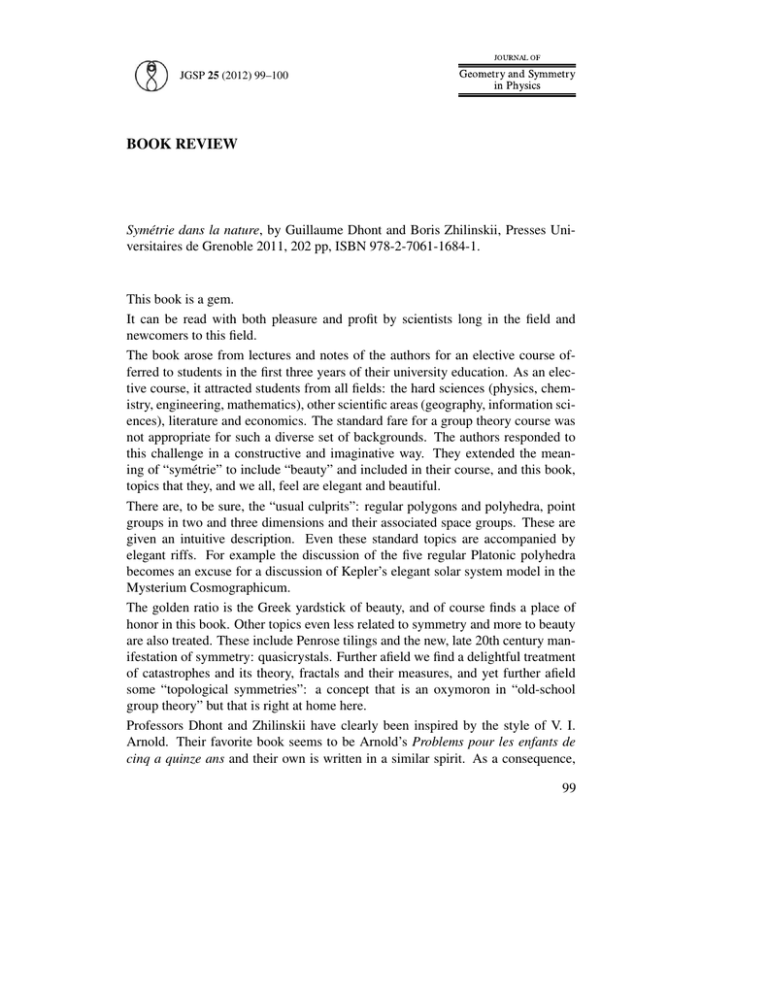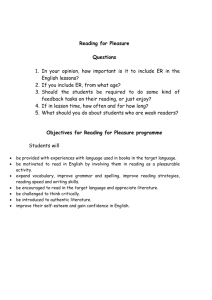BOOK REVIEW
advertisement

JGSP 25 (2012) 99–100 BOOK REVIEW Symétrie dans la nature, by Guillaume Dhont and Boris Zhilinskii, Presses Universitaires de Grenoble 2011, 202 pp, ISBN 978-2-7061-1684-1. This book is a gem. It can be read with both pleasure and profit by scientists long in the field and newcomers to this field. The book arose from lectures and notes of the authors for an elective course offerred to students in the first three years of their university education. As an elective course, it attracted students from all fields: the hard sciences (physics, chemistry, engineering, mathematics), other scientific areas (geography, information sciences), literature and economics. The standard fare for a group theory course was not appropriate for such a diverse set of backgrounds. The authors responded to this challenge in a constructive and imaginative way. They extended the meaning of “symétrie” to include “beauty” and included in their course, and this book, topics that they, and we all, feel are elegant and beautiful. There are, to be sure, the “usual culprits”: regular polygons and polyhedra, point groups in two and three dimensions and their associated space groups. These are given an intuitive description. Even these standard topics are accompanied by elegant riffs. For example the discussion of the five regular Platonic polyhedra becomes an excuse for a discussion of Kepler’s elegant solar system model in the Mysterium Cosmographicum. The golden ratio is the Greek yardstick of beauty, and of course finds a place of honor in this book. Other topics even less related to symmetry and more to beauty are also treated. These include Penrose tilings and the new, late 20th century manifestation of symmetry: quasicrystals. Further afield we find a delightful treatment of catastrophes and its theory, fractals and their measures, and yet further afield some “topological symmetries”: a concept that is an oxymoron in “old-school group theory” but that is right at home here. Professors Dhont and Zhilinskii have clearly been inspired by the style of V. I. Arnold. Their favorite book seems to be Arnold’s Problems pour les enfants de cinq a quinze ans and their own is written in a similar spirit. As a consequence, 99 100 Book Review their lucky students are subjected to a grand tour of some of the most exciting developments in mathematics, physics, and chemistry of the 20th century. The text if full of figures (162), each chosen with care and useful for illustrative purposes. Many are of naturally occuring objects that conform to, or stimulated, the ideas presented in the text. There are exercises throughout (45), and not of the make-work kind. They are chosen with a sly smile and are informative to the long-term workers in the field as well as the newcomer. The text itself runs 144 pages and the chapter containing solutions to the exercises another 43. It is clear that the authors took a great pleasure of borrowing exciting exercises from other (acknowledged and apocryphal) sources and devising solutions that are at the same time informative, imaginative, and a pleasure to consider. This book is a pleasure to read and to reread. Robert Gilmore Physics Department Drexel University Philadelphia, PA 19104 E-mail address: robert.gilmore@drexel.edu
